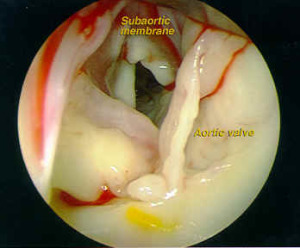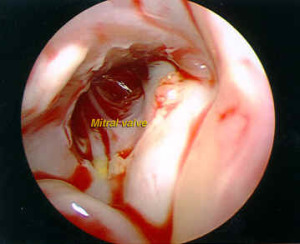

Subaortic membrane is a fibrous membrane below the aortic valve that may involve the ventricular septum, the anterior leaflet of the mitral valve, and the aortic valve itself. It may be associated with other structural anomalies of the aortic valve, such as bicuspid aortic valve, and other abnormalities of the left ventricular outflow tract, such as in atrioventricular canal or tunnel subaortic stenosis
Physiology and Pathology
The subaortic stenosis causes problems in several different ways. It may obstruct left ventricular outflow and cause subaortic stenosis. The resultant effects are essentially the same as valvular aortic stenosis: left ventricular hypertrophy from the pressure overload, myocardial ischemia (too little blood flow to the heart, which may cause a heart attack) heart failure, and sudden death.
In addition, a subaortic membrane may alter left ventricular outflow dynamics and harm the aortic valve without any significant obstructive component. The abnormal flows cause aortic insufficiency (a leaking aortic valve) and permanent structural damage to the aortic valve.
There may be other effects from subaortic membrane as well, including permanent damage to the mitral valve and direct damage to the aortic valve, if the membrane grows up into the aortic valve itself.
The abnormal flow characteristics that initiate the growth of a subaortic membrane may allow the re-growth of the membrane, even after complete resection.
Surgical Indications and Approach
Surgery is indicated when a) the subaortic stenosis becomes hemodynamically significant, that is, when the gradient increases to the point that there is a significant pressure load on the left ventricle or b) when there is any evidence that the aortic valve is involved, that is, by presence of any aortic insufficiency whatsoever.
Surgery for subaortic membrane requires complete removal of the membrane and frequently may involve resection of septal muscle as well.